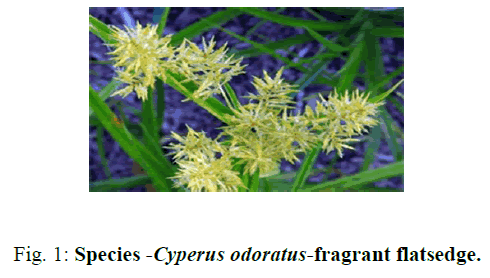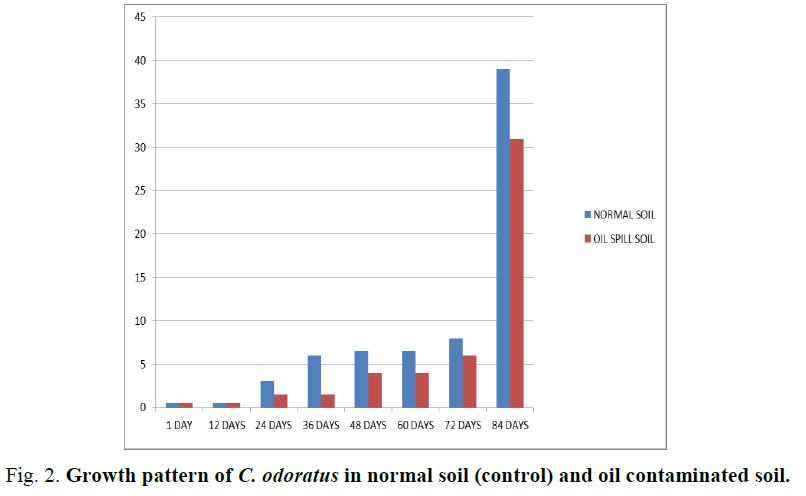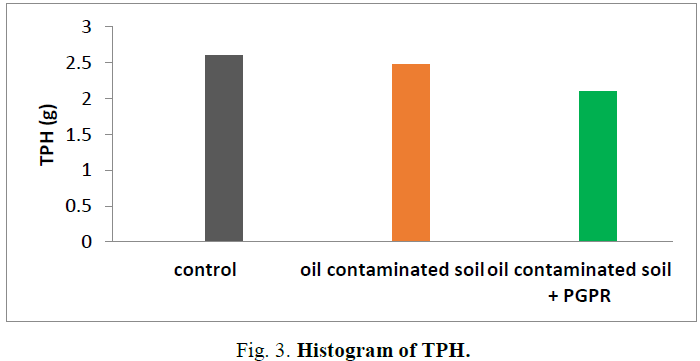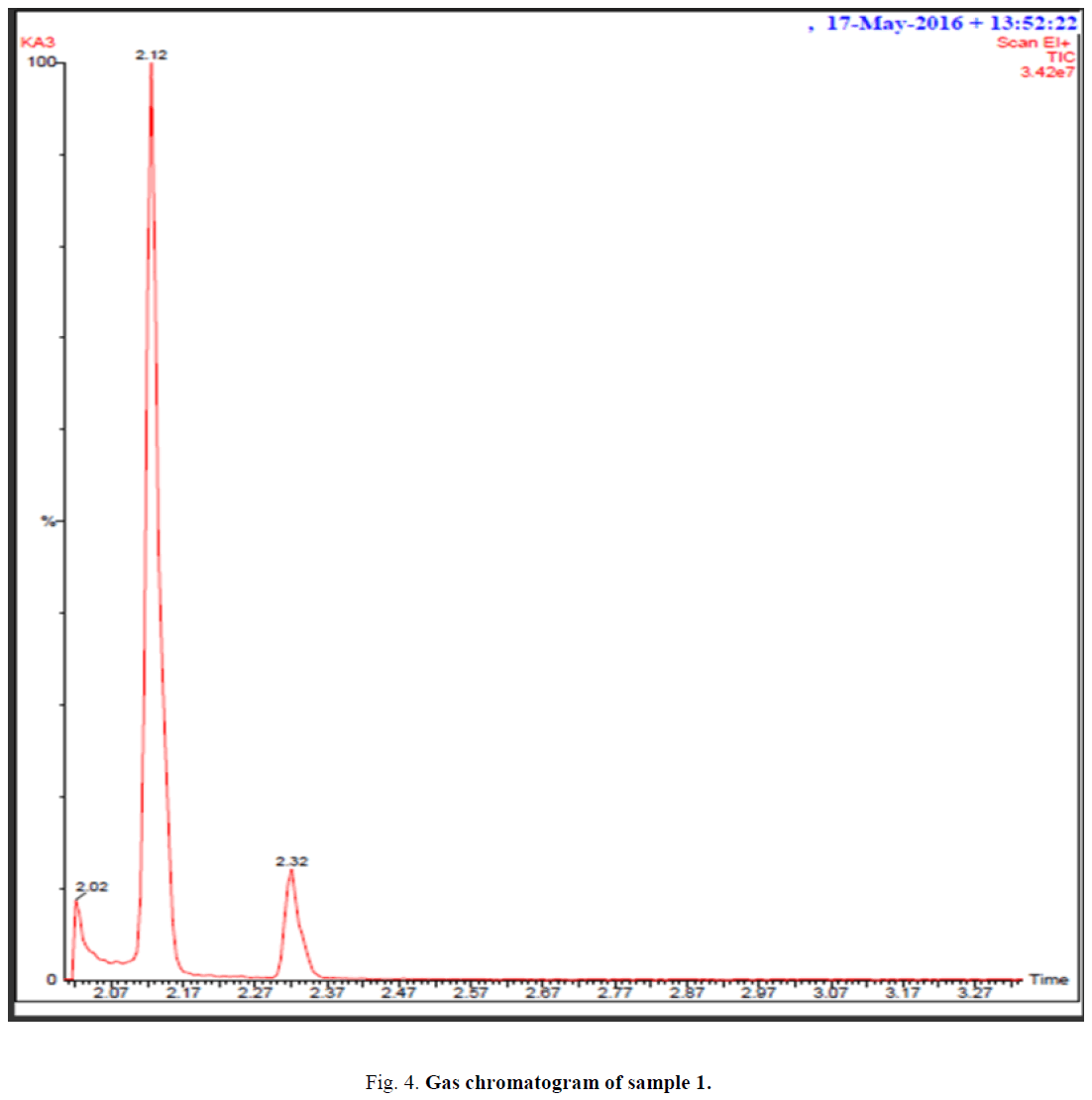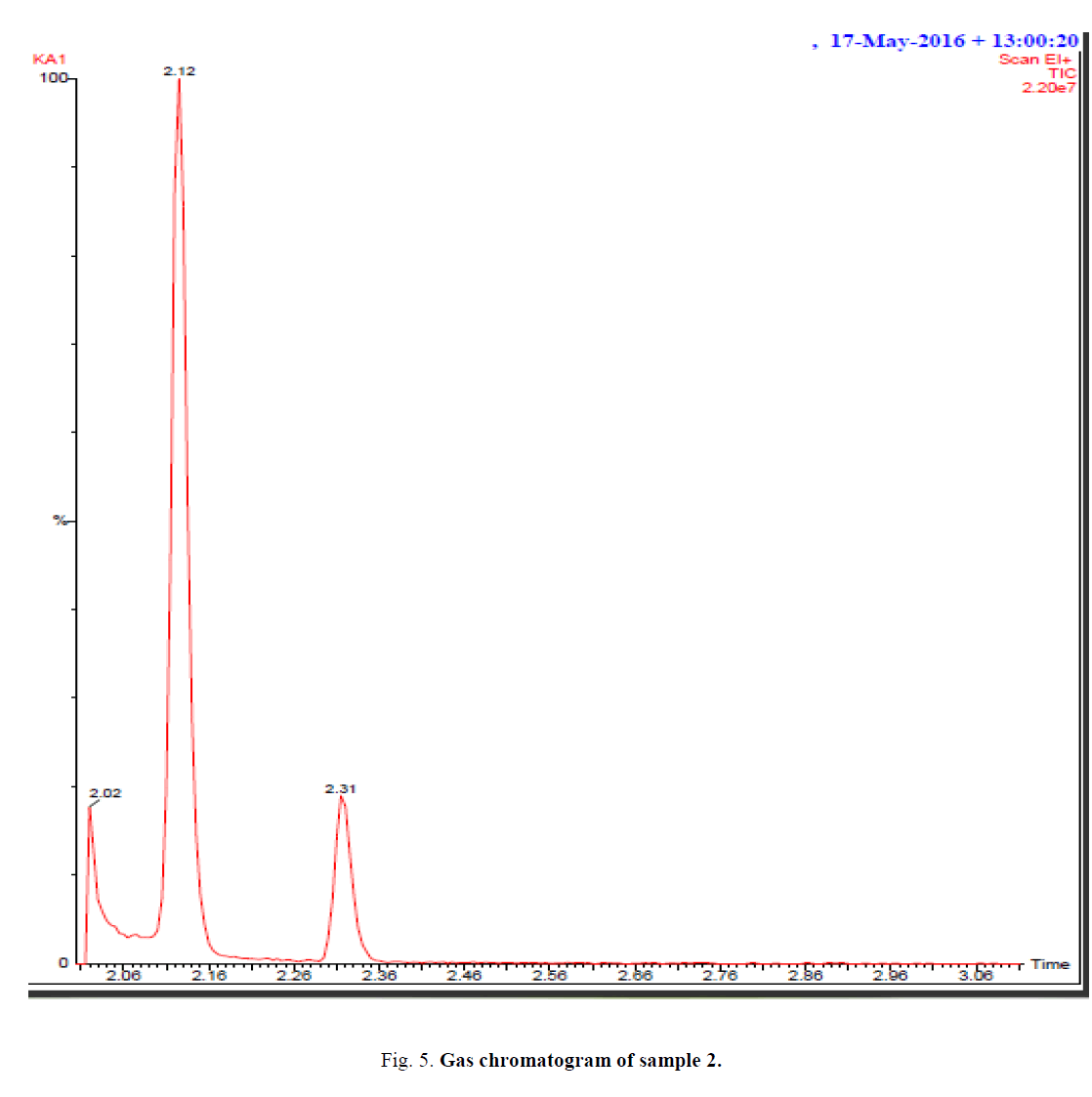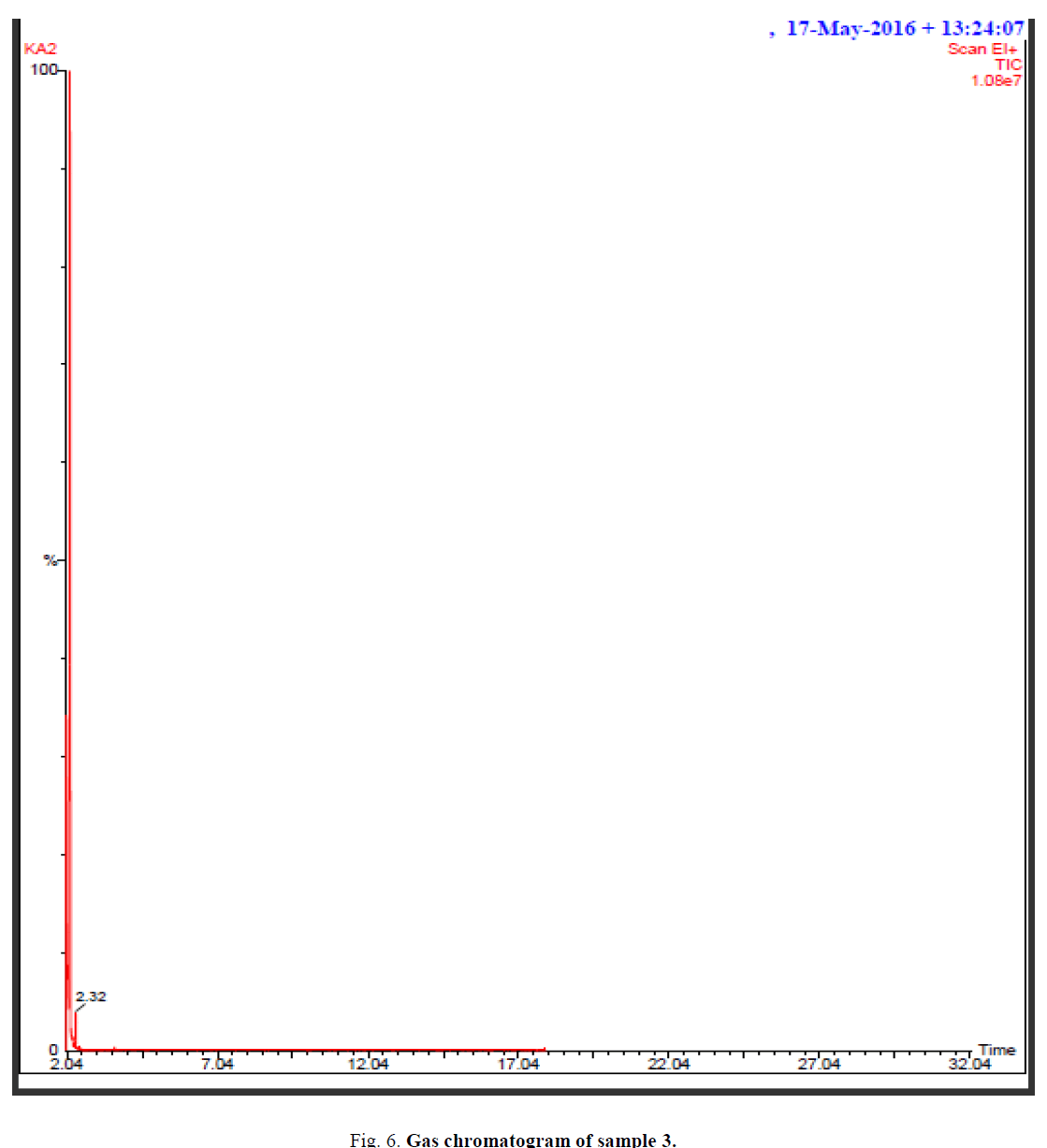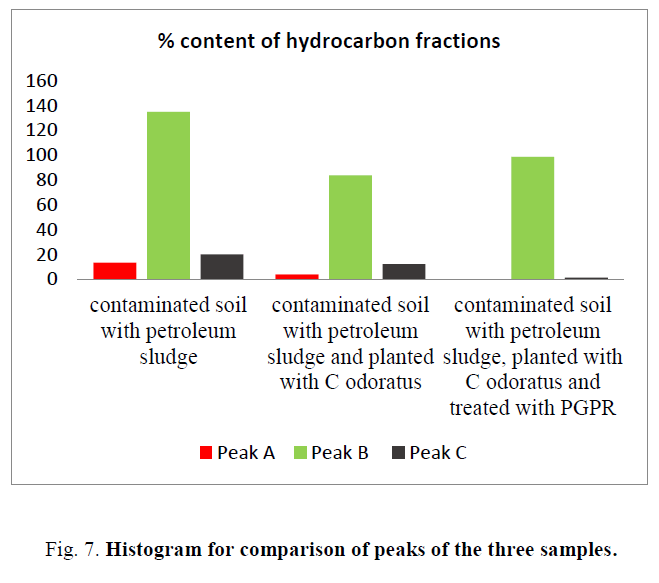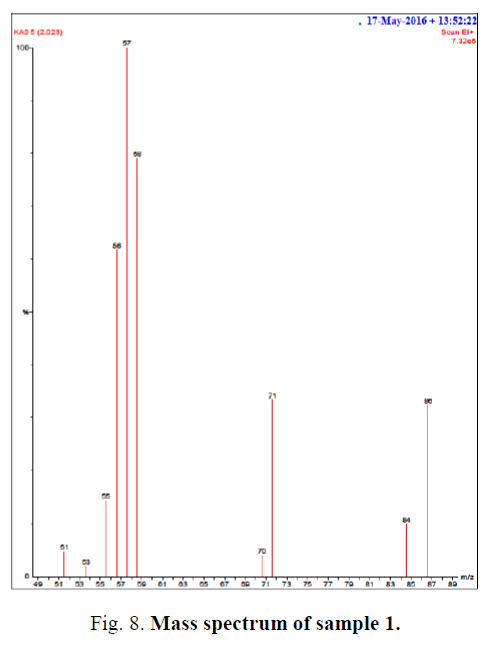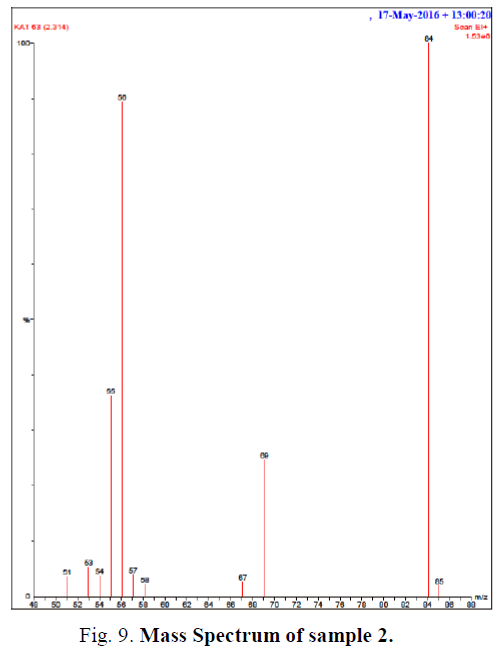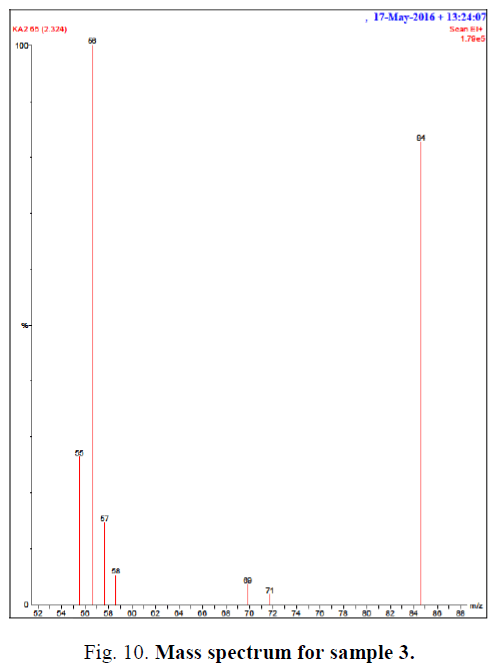Original Article
, Volume: 14( 3)Synergistic Effect of Cyperus odoratus & PGPR Strain in Hydrocarbon Uptake from Oil Contaminated Soil
- *Correspondence:
- Minakshi Bhattacharjee , Assistant Professor, Department of Biotechnology, Assistant Professor, Department of Biotechnology, Assam down Town University, Panikhaiti, Guwahati, Assam, India, Tel: 91-9864108115; E-mail: minakshibhattacharjee2007@gmail.com
Received: March 19, 2018; Accepted: May 29, 2018; Published: June 01, 2018
Citation: Bhattacharjee M, Mahanta K, Sarma MP. Synergistic Effect of Cyperus odoratus & PGPR Strain in Hydrocarbon Uptake From Oil Contaminated Soil. Biotechnol Ind J. 2018;14(3):165.
Abstract
Background: Petroleum is the main source of energy as fuel. Petroleum leakage or dumping of petroleum waste can lead to contamination of soil and ground water. Some major sources of oil spills are leaking storage tanks, pipelines, land disposal of petroleum waste and accidental spills. Phytoremediation is the use of plant and its associated micro-organisms. Objectives: This study aims to use sedge species, C. odoratus and PGPR strains for phytoremediation of oil sludge contaminated soil. Materials and Methods: The plant was grown in two conditions viz., oil contaminated soil as well as contaminated soil containing PGPR. The growth pattern of the plant in both conditions was observed. Total petroleum hydrocarbon (TPH) was estimated using Soxhlet extraction method. The TPH samples were further analyzed by GC-MS. Results: A better growth was observed when the contaminated soil was treated with PGPR one month after the planting of C. odoratus. Initially when treated with the plant there was no change in the amount of total petroleum hydrocarbon but after treating with PGPR strains there was a decrease in the concentration of total petroleum hydrocarbon. Moreover, GCMS reveals that there is a breakdown of hydrocarbon when the soil are planted with C. odoratus and treated with Plant Growth Promoting Rhizobia (PGPR). Conclusion: A synergistic effect of Cyperus odoratus & PGPR strain in hydrocarbon uptake was observed. So, this combination could be effectively used to restore vegetation in oil spilled sites.
Keywords
Phytoremediation; PGPR; GCMS; C. odoratus
Background
Crude oil is used as a raw material for production of petroleum products. Eg diesel, petrol, paraffin waxes and other chemicals. It is the most important source of energy in the current time. Due to exploration, production, transportation, storage, and leakages, there is addition of hazardous chemicals to the ecosystem.
Oil spill is a major threat to environment. Moreover, it causes soil pollution, water pollution. Due to terrestrial oil spill, growth of vegetation becomes unfavorable [1]. The application of biotechnological process for removal or breaking of petroleum hydrocarbon present in soil by application of micro- organism and plant is called bioremediation. The application of plant in breakdown of hydrocarbon or its uptake is called phytoremediation. Oil spillage causes a disproportionate carbon /nitrogen ratio at spilled site [2] as crude oil is a mixture of carbon and hydrogen. This causes a deficiency of nitrogen in the oil soaked soil and large concentration of organic compounds in the top layer of the soil deplete the oxygen reserve in the soil and slow down its diffusion rate into the deeper area of the soil and hence interferes with the vegetation.
Oil spill is usually refers to spillage in marine ecosystems, where crude oil or petroleum products are released in ocean water or coastal water. It might occur in land, and penetrate into the plumage and even fur of animals, therefore reducing its capacity of insulation. Such spills may take years for its clean up.
Bioremediation is a widely used and it has many advantages in relation to other processes employed to remove the pollutants such as extraction with solvents of chemical oxidizers [3-7]. There are incidences of successful application of plant species in bioremediation of oil contaminated soil and it has been shown in a number of studies [8-13].
Most studies on phytoremediation of hydrocarbon contaminated soil used different species of grass as because grasses composes a fibrous root system and covers a greater surface area then other species and can penetrate into the soil of up to 3 m [14].
Cyperus odoratus is a plant that is commonly found in damp areas of Northeast, India and also found growing in contaminated areas. It is a species of sedge known by the common names fragnant flatsedge and rusty flatsedge. This plant can be found in much of the tropical and warm temperate world, including India (Northeast region), central and North America, south East Asia, Australia and central Africa. It is a plant that usually grows in wet lands, muddy areas, including some disturbed and altered sites. The species C. odoratus is quite variable and may in fact be more than one species included under one name. The Cyperus itself have more than six hundred different species. In this study, an attempt has been made to explore the phytoremedial capacity of this grass species against oil contamination. We also analyzed the combined effect of this grass and PGPR strain on hydrocarbon uptake.
Objectives
The current study was aimed with the following objectives.
1) To observe the effect of C. odoratus plant and its combined effect with PGPR strain on oil sludge.
2) To analyze the hydrocarbon uptake by the plant and interpret its phytoremedial efficiency.
Materials and Methods
The oil contaminated soil samples were collected from Indian Oil Corporation (Noonmati Refinery, Guwahati, Assam, India) 26.18•N, 91.80 •E. The soil sample mostly consists of petroleum sludge that is deposited in a particular area. An unpolluted garden soil was also collected (Sample 1 control). Both soil samples are tested for pH, moisture content and texture. Then both the soil samples were weighed (1 kg) and filled in pots.
10 gm of the oil contaminated soil was weighed and initial amount of petroleum hydrocarbon was extracted using Petroleum ether as solvent in Soxhlet apparatus for 24 hrs. The extract so obtained was stored in a sealed bottle for further experiment. Saplings of plant C. odoratus were planted in the two pots control and soil containing sludge respectively. The plants were allowed to acclimatize and watered regularly for 1 month. The plant height were also measured against control and recorded.
The contaminated soil of the pot after 1 month of planting C. odoratus was extracted (10 gm) from its rhizosphere and is evaluated for any decrease in the level of initial total petroleum hydrocarbon. The TPH was extracted using a Soxhlet apparatus with petroleum ether as solvent for 24 hrs. The extracted sample was collected in a glass bottle and sealed (sample 2).
The PGPR strain (Rb1 and Rb2) were collected from CSIR-NEIST, Assam Biotechnology division. A subculture of PGPR was prepared in 200 ml of nutrient broth. The subcultured PGPR strains were transferred in two separate sterilized spraying bottles. These strains were sprayed to the plants and observed for 1 month. 10 gm of oil contaminated soil was sampled from the rhizosphere of the plant and the total petroleum hydrocarbon was extracted using petroleum ether as solvent in Soxhlet apparatus (sample 3) and the extracted sample was kept in sealed glass bottle.
The three samples (1,2 and 3) were concentrated using rotatory evaporator and concentrated to 1 ml. The concentrated samples were collected in vials and were taken for gas chromatography mass spectrometry analysis. The residual soil after extraction of TPH was weighed to see the decrease in TPH levels.
Result
The pH, moisture content, and the texture of the soil are presented in TABLE 1. In the control sample, the height of the plant was found to gradually increase and on the 84th day a maximum height of 39 cm was recorded. In the oil spill or petroleum sludge treated soil, the plant grew up to 1.5 cm till 30 days and following PGPR treatment after 30 day, there was abrupt increase in the growth pattern. It attained a maximum height of 31cm on the 84th day (TABLE 2 and Figs. 1 and 2).
| Parameters | Normal soil | Oil spill soil |
|---|---|---|
| Ph | 7.73 | 6.20 |
| Moisture content | 25% | 7% |
| Texture | Loamy | Sandy |
Table 1: Table showing various parameters.
| Days | Normal soil (control) cm | Oil spill soil (cm) |
|---|---|---|
| 1 Day | 0.5 | 0.5 |
| 12 Days | 0.5 | 0.5 |
| 24 Days | 3 | 1.5 (Application of PGPR) |
| 36 Days | 6 | 1.5 |
| 48 Days | 6.5 | 4 |
| 60 Days | 6.5 | 4 |
| 72 Days | 8 | 6 |
| 84 Days | 39 | 31 |
Table 2. Table showing plant height with respect to time (in days).
Fig. 1: Species -Cyperus odoratus-fragrant flatsedge.
The TPH of the three soil samples were found to be 2.60 gm, 2.48 gm and 2.10 gm respectively (Fig. 3).
The total petroleum hydrocarbon analysis showed that initial and planted soil had little difference in the quantity of the TPH. Further, when the soil was treated with PGPR strain, the TPH decreased to 2.10 gm. Thus it provided an initial indication that the combined effects of C. odoratus & PGPR strains played a good role in the hydrocarbon uptake from oil contaminated soil.
GC-MS analysis
The % concentration of each peak was calculated using the formula: Area of the peak=h× ½ w
Where h=height of peak above baseline, ½ w=width of peak at half of its height
%=Individual area of peak/Sum of total area of peak×100
The GC chromatograph of samples 1, 2, 3 is revealed in Figs. 4-6 respectively. A comparative analysis is shown in Fig. 7.
The concentration of the hydrocarbon fraction decreased gradually in sample 1,2 and sample 3 as observed for peals A and C. The concentration of Hydrocarbon of peak A was found to be very negligible in sample 3. There is also a considerable difference in hydrocarbon fraction concentration in peak B between samples 1 and 2. However, the hydrocarbon concentration increased in sample 3 for peak B as compared to sample 2.
The MS analysis for sample 1,2,3 is shown in Fig. 8-10 respectively.
In Sample No 1, the base peak is obtained at 57 with molecular peak and 86 m/z, the fragmentation obtained at 69 and 86 for one -CH3 and two -CH3 respectively
In Sample No 2, base peak obtained at 84 m/z value and molecular ion peak at 85 m/z value. The fragmented peaks are less compared to Sample No 1.The hydrocarbon fractions 51,57,58 are found to be decreased in sample 2 as compared to sample 1(control).
In Sample No 3, base peak obtained at 56 m/z value and the molecular ion peak obtained at 84 m/z value. The hydrocarbon fraction 69,84 in sample 2 decreased in sample 3. Fractions 51,53,54,67, were totally degraded in sample 3 (Fig. 8-10).
Discussion
Oil spill can be defined as release of liquid petroleum hydrocarbon into the environment, due to human activity, eg: transportation, release of sludge by refineries, drilling rigs and wells and by their products or waste. Spilled oil can also contaminate drinking water supplies. Contamination can have an economic impact on tourism. Spill oil can be harmful to living things because of its chemical constituents are poisonous. There is huge impact on terrestrial oil spills due to this there is death of flora and fauna. As spilled oil on lands prevents water absorption by the soil, spills on agricultural location or grassland have the effects of chocking off plant life. Petroleum hydrocarbons are mainly composed of alkanes, cycloalkanes, napthalenes, and aromatic hydrocarbons or as phaltenes. Alkanes can be methane, ethane, propane etc. Alakanes mostly methane are associated with increase in temperature of the atmosphere as its heat trapping ability is more than any greenhouse gas and is highly explosive. Exposure of human beings to napthalenes can cause hemolytic anemia, damage to liver and neurological damage. It is also cause of cataract in rodents and even in human. Aromatic hydrocarbon is also known for animal carcinogens; it causes ground water contamination, and is known to alter DNA sequences in animals causing mutation [15].
Budhadev Basumatry et al. [16,17] carried out assessment of potential plant species for phytoremediation of hydrocarbon contaminated areas of Upper Assam, India using C. odoratus and found that degradation of TPH in fertilized soil is 78% and unfertilized soil is 45%. Jahangir Abedi- koupai [18] (carried a greenhouse study where he treated oil contaminated soil from Tehran Refinery with four different native plants including Agropyron, Lolium, tall fescue and Puccinella distance and after 90 days of planting C:N ratios and microbial population were assessed compared with beginning of the trails and found that the rate of degradation is dependent on the type of plant species selected. Only tall fescue survived it improved the physical structure of the soil and contamination level. Budhadev Basumatary phytoremediated crude oil contaminated soil using nut grass, C. rotundus he took five different concentration of contaminated soil ( 2.05, 4.08, 6.1, 8.15, and 10.2%) and planted C. rotundus, he found that there is a significant degradation of total oil and grease in vegetated pots in compared to vegetated pots.
This study evaluates that initially the plant C. odoratus when planted in contaminated soil undergoes stress full conditions , later when treated with PGPR strain the plant started to grow an there is increase in height of the plant. The initial TPH in the soil was 2.60 gm after 30 days of planting C. odoratus there is no change in TPH but after treating the soil with PGPR there is a 0.50 gm decrease from the initial amount of petroleum hydrocarbon. By comparing the mass spectra of the three samples it was found that some peaks vanished in the sample 3, that were present in sample 1 and 2.
The GC-MS analysis reveals that the hydrocarbon fraction decrease when soil is planted with C. odoratus and moreover, a synergistic effect of C. odoratus & PGPR is observed for increased hydrocarbon uptake. This study can be used effectively to treat dump sites of petroleum sludge and also prevents unwanted leakage to surrounding areas; and it’s after effects to other species of flora & fauna. In this way a waste site can be reclamated.
We have limited our study to soil analysis and further GC analysis of the plant sample both before and after treatment with PGPR can be done. Also there is a scope to study constituents of the peaks and find out which hydrocarbon is specifically up taken by the plant and or plant treated with PGPR. A CHN analysis will reveal a better picture of C:H:N ratio of the fractions.
Conclusion
In the current study of role of C. odoratus and PGPR in hydrocarbon uptake of the oil contaminated soil of Noonmati refinery, we found that there is a decrease of petroleum hydrocarbon from its initial weight of 2.60 gm to 2.10 gm. The GCMS analysis reveals that there is a breakdown of hydrocarbon when soils are planted with C. odoratus and there is more increase in breakdown of hydrocarbon when the soil is treated with plant and PGPR. The findings of the study shall be strengthened with GC analysis of the plant and a C: H: N ratio of the soil sample before and after the treatment.
Phytoremediation has a number of significance, as the cost of phytoremediation is less than other traditional process, the plants can be easily monitored and it is a harmful method because it uses naturally occurring organism and preserves the environment in previous state.
Acknowledgement
The authors acknowledge the support and assistance of Department of Biotechnology, Assam down town University, Assam, India.
References
- https://www.conserve-energy-future.com/various-causes-of-oil-spill.php
- Agbogdigi OM, Eruotor PG, Akparob SO, et al. Evaluation of crude oil contaminated soil on the mineral nutrient elements of Maize (Zea mays L.). J Agron 2007;6:188-93.
- Van Gestel K, Mergaert J, Swings J, et al. Bioremediation of diesel oil-contaminated soil by composting with biowaste. Environ Pollut. 2003;125(3):361-68.
- Gogoi B, Dutta N, Goswami P, et al. A case study of bioremediation of petroleum-hydrocarbon contaminated soil at a crude oil spill site. Adv Environ Res. 2003;7:767-82.
- Nano G, Borroni A, Rota R. Combined slurry and solid-phase bioremediation of diesel contained soils. Haz Mat 2003;100(4):79-94.
- Morelli IS, Del Panno MT, De Antoni GL, et al. Laboratory study on the bioremediation of petrochemical sludge contaminated soil. J Int Biodeter Biodegr 2005;55(4):271-278.
- Demnerova K, Mackova M, Spevakova V, et al. Tow approaches to biological decontamination of groundwater and soil polluted by aromatics characterization of microbial population. Int Microbiol 2005;8(2):20511.
- Gunther TU, Dornberger, Fritsche W. Effects of ryegrass on biodegradation of hydrocarbons in soil. Chemosphere 1996;33:203-15.
- Carmen EP, Crossman TL, Gatiff EG. Phytoremediation of fuel oil contaminated soil. J Soil Contam 1998;7:445-46.
- Pichtel J, Liskanen P. Degradation of diesel fuel in rhizosphere soil. Environ Eng Sci 2001;18:145-57.
- Banks MK, Liu P, Schwab B, et al. The effect of plants on the degradation and toxicity of petroleum contaminants in soil: A field assessment. Adv Biochem Eng Biotechnol 2003;78:75-96.
- Brandt RN, Merkl R, Schultze-Kraft, et al. Potential of Vetiver (Vetiveria zizanioides (L.) Nash for phytoremediation of hydrocarbon-contaminated soils in Venezuela. Int J Phytorem 2006;8:273-84.
- Muratova A, Hübner T, Narula N, et al. Rhizosphere microflora of plants used for the phytoremediation of bitumen-contaminated soil. Microbiol Res 2003;158(2):151-61.
- Aprill W, Sims RC. Evaluation of the use of prairie grasses for stimulating polycyclic aromatic hydrocarbon treatment in soil. Chemosphere. 1990;20(1-2):253-65.
- Bostrom CE, Gerde P, Hanberg A, et al. Cancer risk assessment, indicators, and guidelines for polycyclic aromatic hydrocarbons in the ambient air. Environ Health Perspect 2002;110(Suppl 3):451-88.
- Basumatary B, Saikia R, Bordoloi S. Phytoremediation of crude oil contaminated soil using nut grass, Cyperus rotundus. J Environ Biol 2012a;33(5):891.
- Basumatry B, Saikia R, Bordoloi S, et al. Assessment of potential plant species for phytoremediation of hydrocarbon contaminated areas of Upper Assam, India. J Chem Technol Biotechnol 2012b.
- Abedi- Koupai J, Ezzatiant R, Vossoughi- Shavari M, et al. The effects of microbial population on phytoremediation of petroleum contaminated soils using Tall Fescue. Int J Agric Biol 2007;9:242-46.
